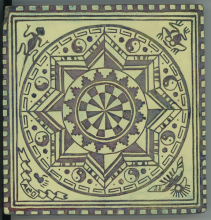 |
|
This is a linoleum block print made by Osa Hidalgo de la Riva. made at the Centro de Arte in Long Beach, within the 'art room.' That was a place where anyone could come to create. Lola offered big white sheets of paper that covered every table, for folks to draw, paint, etc. The walls (ceiling included) were absolutely covered with art from the community and pieces that had been made in the room. Lola de la Riva gave each of her kids a linoleum block to each make their own image and Osa created |
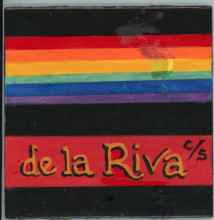 |
|
Lily and Osa have the same birthday, and this piece was made on their birthday. It was made at a store called Petroglyphs in Santa Cruz where customers can choose ceramic pieces to paint or glaze and they are fired and finished by the store. It contains a few of Osa's favorite motifs: rainbows, your family name, Caló calligraphy representative of Osa's long-established typography work. To Osa, as a 'Chicana Lesbiana' "c/s" or "con safos" is an invocation of Sappho, the Greek poet. Osa studied he |
|
|
|
Interview with Elizabeth M. Hidalgo ("Liz") within Spectator Volume 26, No. 1 Spring 2006 Issue ( a journal published by the University of Southern California) edited by Osa while completing her PhD in Film and Television Criticism. The brief biography at the top of the page reads: "Elizabeth M. Hidalgo has worked in a variety of media, from leather-making, haiku writing, cross-stitch sewing, jewelry making and precious stone cutting. She was one of the few earlier female Park R |
|
|
|
Celia de la Riva Rubio's contribution to Spectator Volume 26, No. 1 Spring 2006 Issue ( a journal published by the University of Southern California) edited by Osa while completing her PhD in Film and Television Criticism. This piece is subtitled 'Activist Feminist During the 70's" and details Celia's deep care for her students and the essential role she consciously took as one of two teachers who could be trusted to counsel and help with sexual or reproductive issues. Celia describes counseling |
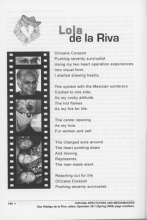 |
|
Excerpt from page 146 of Spectator Volume 26, No. 1 Spring 2006 Issue ( a journal published by the University of Southern California) edited by Osa while completing her PhD in Film and Television Criticism. This page features a poem from Lola de la Riva alongside an illustrated film reel filled with photos of Lola, and her daughters Liz and Osa. In the upper left corner is a line drawing of the heart illustration made by Lola de la Riva and featured on the issue cover. The poem reads: "Chicana C |
|
|
|
Cover of Spectator Volume 26, No. 1 Spring 2006 issue (a journal published by the University of Southern California) which was edited by Osa while she was a student completing her PhD in Film and Television Criticism. She made sure to highlight Chicana artists, her family, and a few other feminist alies of all genders. Full title is, "Spectator: Chicana Spectators and Mediamakers Imagining TransCultural Diversity." The cover image was designed by Lola de la Riva and is described in a poem contai |
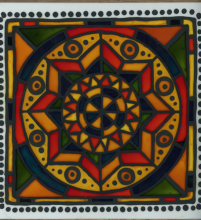 |
|
Based on an original linoloeum block made by Osa that was used as the logo for the Centro de Arte in Long Beach established by Lola de la Riva. It is a kind of mandala that represents unity, family, and balance. |
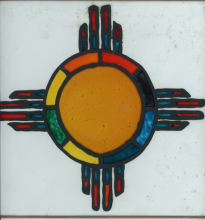 |
|
A New Mexico-style sun derived from Zuni or Pueblo communitites. For Osa, it represent the four directions, four elements, and four seasons. It was likely made in Hayward. |
|
|
|
Dichosas Terri y Liz poem published by Celia de la Riva Rubio in English and Spanish. This poem was dedicated to Osa Hidalgo de la Riva and her sister Liz de la Riva and illustrates their connection. |
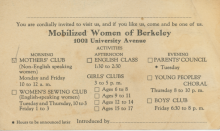 |
|
Invitation card for "Mobilized Women of Berkeley" at 1002 University Avenue. The box for "Morning Mother's Club (Non-English speaking women) is checked in pencil. Osa Hidalgo de la Riva Hidalgo believes Angela Rubio de la Riva likely owned this card and was a member. Osa has heard that "Grandma Angie" was a member of a "woman's organization" in Berkeley and taught cooking and painting classes within that group (possibly the organization named on this card). Angela also purchased a home and used |
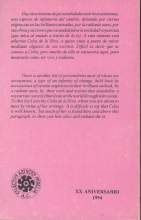 |
|
Back cover of Lagrimas y Cadenas/Chains and Tears book. Includes brief summary in both English and Spanish, a logo from Colectivo Artistico Morelia A.C., (the likely publishers of the book), and the words "XX Aniversario 1994" in the bottom right corner. |
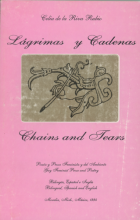 |
|
Culmination of writings Celia de la Riva Rubio had produced for decades. Published in Morelia, Mexico. Celia was dissappointed with Spanish translation and she created a second version with corrected translations inserted as a separate one-page included in the book. "Gay Feminist" is an example of the ways Celia used and developed language, words, and phrases to more accurately represent her identity; and the ways identity terms have shifted over time. |








